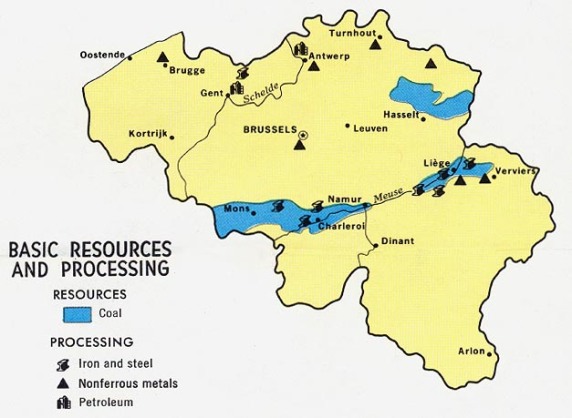GEOGRAPHY
The sillon industriel (French for “industrial valley”) is the former industrial backbone of Belgium. It runs across Wallonia (Belgium’s Southern state) passing from Dour, in Borinage, in the west, to Verviers in the east, through Mons, La Louvière, Charleroi, Namur, Huy, and Liège, following the valleys of the rivers Haine, Sambre, Meuse and Vesdre, and has an area of roughly 1000 km².
It is also known as the Sambre and Meuse valley, as those are the main rivers, or the Haine-Sambre-Meuse-Vesdre valley, which includes two smaller rivers.
It is less defined by physical geography, and is more a description of human geography and resources. As heavy industry is no longer the prevailing feature of the Belgian economy, it is now more common to refer to the area as the former industrial belt.
POPULATION + ECONOMY
Around two-thirds of the population of Wallonia (Belgium’s southern state) lives in the area – over two million people. Its main stretch is sometimes called the Charleroi-Liège valley, which connects Charleroi and Liège. Some see it as a Walloon metropolis, albeit much more linear and less centralized than most.
The sillon industriel (located in Wallonia-Belgium’s southern state) was the first fully industrialized area in continental Europe. Its industry brought much wealth to Belgium, and it was the economic core of the country. This continued until after World War II, when the importance of Belgian steel, coal and industry began to diminish. The region’s economy shifted towards extraction of non-metallic raw materials such as glass and soda, which lasted until the 1970s. The days of prosperity were gone, however, and a trend of unemployment and economic dependence on the formerly poorer Flemish Region (Belgium’s northern state) began, and continues to this day.
The region has seen numerous general strikes, some with social aims, some with political aims. In 1886, due to economic crisis, lowering of salaries and unemployment; in 1893, 1902 and 1913, as a struggle for universal suffrage. More strikes occurred in
1932 and 1936, with a strike in 1950 on the question of the return of Leopold III to the Belgian throne. The region was at the heart of the general strike of winter 1960-1961, which helped Wallonia to gain autonomy.
